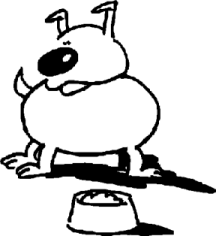Previous Page | Right click this page to print.
Feeding Levels and Overweight Pets
This calculation we just went through, it is a guideline. It’s never hard and fast because you’re not exactly sure how your animal might react. Obviously, what you want to do, if you start into this, you want to take an initial body weight and you want to make sure that there’s no, if they’re at a pretty good body weight, that there’s no big gain or loss because you want to keep track of that. Are they gaining weight? Then, maybe I’m feeding them too much. If they’re losing too much weight, then I may not be feeding them enough and I have to readjust what I’m feeding them. Their body condition. You should be able to feel their ribs. If they’re an obese dog, you actually cannot feel the ribs at all. They should have a tuck in here. If this doesn’t exist, there again, you have an overweight dog. Just looking at their condition will give you an idea of how they’re actually doing. Now, a very thin dog, this is going to be very pronounced here. You can actually see the ribs, which, that’s an extreme case. You don’t want to have to see that in an animal. Those are things you don’t want to see. Stool size and the frequency of the defecation. If you’re feeding too much, they may be leaving, it may be going out the other end, they’re not getting any value out of it. If they’re going out a lot that tells you you’re feeding too much. Eating behavior. Do they look...I know he’s always hungry. But these dogs can get really ravenous and if you have these other conditions that are showing up, their body condition doesn’t look good, the food might not be meeting their needs. And, obviously, if you do things right, you shouldn’t end up with an overweight pet.

Previous Page | Right click this page to print.